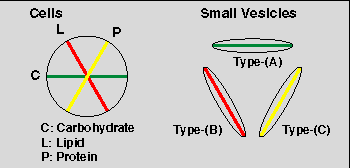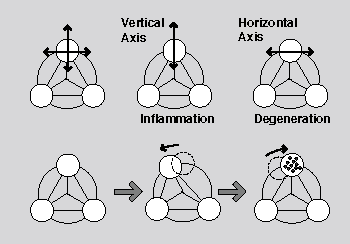 |
 |
|
|
|
 |
IV. Degeneration 2/2
Consider theoretically how a tissue causes degeneration. |
|
|
|
|
(c) Special Characteristic of Small Vesicles
Next, let us consider what special characteristic small vesicles have. Small vesicles, which can be observed in a degenerative tissue and in a cell, can be considered to have a special characteristic a normal cell does not have. Small vesicles are usually made from one of the basic components of a cell such as lipid, protein, carbohydrate and so on. Because of this structure, small vesicles can be considered to have extreme physical characters compared with a cell. In other words, we can say that small vesicles have extreme characters compared with cells. Thus, when a cell manufactures small vesicles in it, it can change its original cellular character into new one. |
|
|
|

|
|
(When we regard a cell as a circle, we can regard as mall vesicle as an ellipse. The reason is as follows: although a cell is made of basic components in a human body such as carbohydrate, lipid, and protein, a small vesicle is made of one of the basic components.) |
|
|
|
(d) Theoretical model clearly showing the difference between degeneration and other two major pathological changes: inflammation and tumorigenesis
What theoretical model allows us to show clearly the difference between degeneration and other two major pathological change? Just the figure below indicates the model. A cell can theoretically be considered to move along two axes: a vertical and a horizontal axis. The vertical axis enables us to indicate how much momentum a cell contains; the horizontal one enables us to indicate what cellular character a cell has. Thus, when a cell moves along the vertical axis, it changes the momentum and causes inflammation. On the other hand, when a cell moves along the horizontal axis, it manufactures small vesicles and causes degeneration; as a result, it changes its original cellular character according to the small vesicles. The figures below show these mechanisms. |
|
|
|
 |
|
(In the figures above, when a cell moves along the vertical axis, it causes inflammation. When a cell moves along the horizontal axis, it causes degeneration.) |
|
|
|
2. Conclusion
In conclusion, theoretical analysis of degeneration allows us to indicate the following two points. First, degeneration completely differs in pathological change from inflammation and tumorigenesis. Second, whereas inflammation and tumorigenesis are pathological changes related to cells: the smallest dynamic systems; on the other hand, degeneration is a pathological change related to small vesicles: smallest static systems.
|
|
|
|